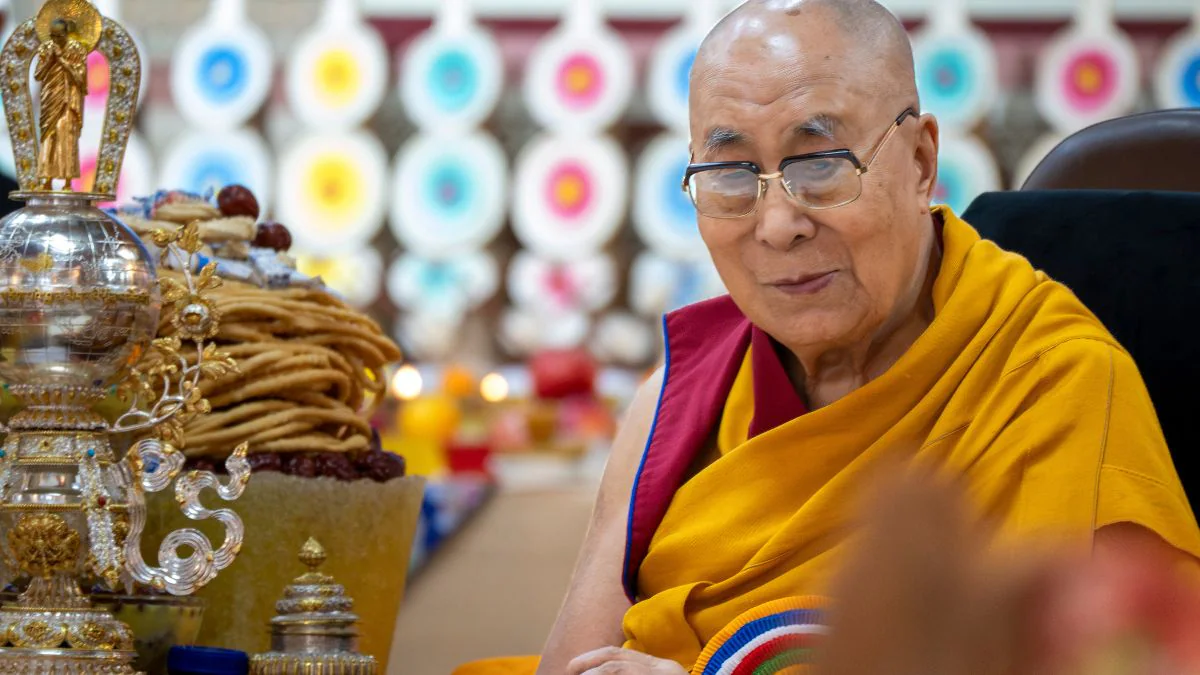
Draw a Moral Line – The Dalai Lama’s Succession and India’s Strategic Conscience
Introduction: Why This is in News
On July 6, 2025, His Holiness Tenzin Gyatso, the 14th Dalai Lama, turns 90. This is not merely a personal milestone of a religious leader; it is a defining moment in the history of modern Asian geopolitics and spiritual resilience. The issue that now stands before the global community is stark: Who will decide the identity of the next Dalai Lama?
This question is not symbolic alone. It has tangible implications for international law, religious freedom, Tibetan cultural identity, and India-China strategic relations. The Chinese Communist Party (CCP), which controls Tibet since the 1950s, has openly expressed its intention to appoint the next Dalai Lama, a move that violates not only Tibetan spiritual customs but also global norms of religious autonomy.
In a significant response, the Dalai Lama has declared that the Gaden Phodrang Trust, founded under his moral and institutional leadership, will oversee the process of identifying his reincarnation. This article, written by Prof. Amitabh Mattoo, calls upon India and the global community to recognize this spiritual stand and to draw a moral line—to oppose China’s coercive policies and uphold the dignity of the Tibetan people.
Historical and Geopolitical Background
Tibet, once an independent theocratic nation, was annexed by China in 1950 under what Beijing calls a “peaceful liberation.” In 1959, following a failed uprising against Chinese rule, the Dalai Lama fled to India, where he was granted asylum. Dharamshala in Himachal Pradesh became the seat of the Tibetan government-in-exile.
Over the decades, the Dalai Lama became not just a religious figure but a global ambassador for non-violence, compassion, and democratic values. Meanwhile, China sought to systematically erode Tibetan culture by:
- Replacing religious leaders.
- Controlling monasteries.
- Introducing Mandarin education in Tibetan schools.
- And now, attempting to choose the next Dalai Lama.
- Dalai Lama’s Bold Declaration
His Holiness has made it clear that the Gaden Phodrang Trust will identify his successor. This ensures that the selection remains purely Tibetan in origin, based on traditional methods like spiritual visions, astrological signs, and recognition by senior lamas—not dictated by a political party.
- This Is Not Just a Religious Dispute
The article rightly argues that this is a civilisational battle. It pits:
- Spiritual autonomy vs. authoritarian control
- Dharma vs. dictatorship
- Faith vs. fabrication
Beijing wants to transform Tibetan Buddhism into a state-sanctioned version of faith, where religion is subservient to political ideology.
- China’s Track Record of Manipulating Tibetan Faith
In 1995, the Dalai Lama identified a child as the 11th Panchen Lama, the second most important figure in Tibetan Buddhism. The Chinese government abducted this child and replaced him with their own version. To date, the original Panchen Lama has not been seen. Now, Beijing wants to repeat this model with the Dalai Lama.
- The Golden Urn Controversy
The Golden Urn is an 18th-century Qing-era ritual, cited by China as their justification to select Tibetan leaders. However, Tibetan spiritual tradition never treated it as binding. Instead, reincarnations are identified through deep introspection, karmic signs, and monastic wisdom. The use of Golden Urn by Beijing is an attempt to forge legitimacy through ancient-sounding, state-approved mechanisms.
- Establishment of the Gaden Phodrang Trust
The Trust was created to ensure that succession is kept beyond the reach of Chinese political control. It is composed of spiritual scholars and senior monks who follow traditional Tibetan processes. By declaring the Trust as the authority, the Dalai Lama has safeguarded the sacred continuity of his lineage.
- India’s Historic Responsibility
India’s civilisational bond with Tibet goes beyond political asylum. In 1954, India recognized Tibet as part of China—a strategic blunder many believe India made under pressure. Since then, India has maintained a deliberate ambiguity to avoid angering China. However, Mattoo calls on India to move from ambiguity to assertive clarity. As a democracy and ancient land of dharma, India must support the Tibetan people’s spiritual sovereignty.
- Geostrategic Concerns for India
If China succeeds in appointing a puppet Dalai Lama:
- It will increase its soft power along the Himalayas.
- It will use religion to influence Buddhist communities in Sikkim, Arunachal Pradesh, Ladakh, and even in Sri Lanka and Nepal.
- It may cause social unrest, weaken Indian Buddhist institutions, and reframe Tibetan resistance as “anti-China extremism.”
Thus, this issue is not just spiritual—it is a matter of national security.
- The Reincarnation Process in Tibetan Buddhism
Contrary to political processes, the reincarnation of a Dalai Lama is a spiritual identification:
- It’s not hereditary.
- It involves a search committee of monks.
- Clues come from visions, dreams, and objects chosen by the child.
Only Tibetans practicing authentic religious methods can identify the reincarnated Lama. A CCP-appointed child will lack credibility and spiritual authority.
- His Holiness at 90: Symbol of Moral Authority
The Dalai Lama is a Nobel Peace Laureate, a proponent of interfaith harmony, and a global teacher of compassion. At 90, he embodies:
- Moral courage
- Spiritual clarity
- Peaceful resistance
He has led the Tibetan movement without violence, unlike many global resistance movements. Supporting his decisions now is a moral duty for democracies.
- Drawing the Moral Line
Mattoo ends with a plea: The world must draw a moral line. The reincarnation of the Dalai Lama must not be decided in Zhongnanhai (China’s political HQ), but in Lhasa, Dharamshala, and the hearts of Tibetan monks and believers. India must be on the right side of this civilisational frontier.
Legal, Ethical & Constitutional Analysis for CLAT 2026
- Legal and Constitutional Relevance
This issue intersects multiple legal domains relevant for law aspirants:
- Article 25 of the Indian Constitution guarantees the freedom of conscience and the right to practice, profess, and propagate religion.
- Article 21 ensures the right to life with dignity, which includes spiritual self-determination.
- Under International Human Rights Law, religious minorities have the right to select spiritual leaders without state coercion (UN Declaration on the Rights of Indigenous Peoples).
- Ethical & Global Diplomacy Angle
From an ethics and international relations lens:
- Can political convenience override spiritual truth?
- Should democracies tolerate the manufacture of faith for diplomatic silence?
- What is India’s ethical responsibility toward a leader who has lived on Indian soil for 65 years?
Explanation of Key Terms (CLAT Glossary)
Term | Meaning |
Dalai Lama | Spiritual leader of Tibetan Buddhism, believed to be a reincarnation of Avalokiteshvara. |
Panchen Lama | Second-most important lama in Tibetan Buddhism; plays a role in identifying Dalai Lama’s reincarnation. |
Golden Urn | Chinese method from the Qing dynasty used to choose religious leaders — rejected by traditional Tibetans. |
Gaden Phodrang Trust | Trust founded by the Dalai Lama to manage his spiritual and administrative legacy, including succession. |
Zhongnanhai | The central headquarters of the Chinese Communist Party in Beijing. |
Reincarnation | In Tibetan Buddhism, a spiritual leader is reborn in a new body to continue guiding the community. |
Conclusion: Where India and the World Must Stand
India must now decide: Does it remain silent to avoid confrontation, or does it embrace its ancient responsibility as a spiritual sanctuary and democracy? Standing by the Dalai Lama is not just about Tibet—it’s about preserving the freedom to believe, the right to dissent, and the soul of a civilisation.




